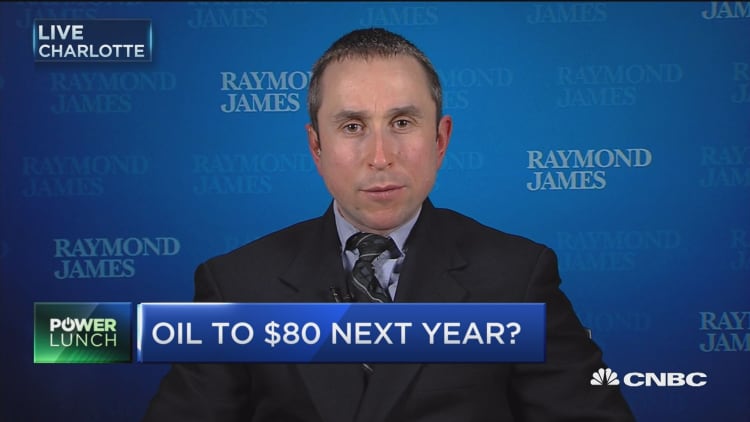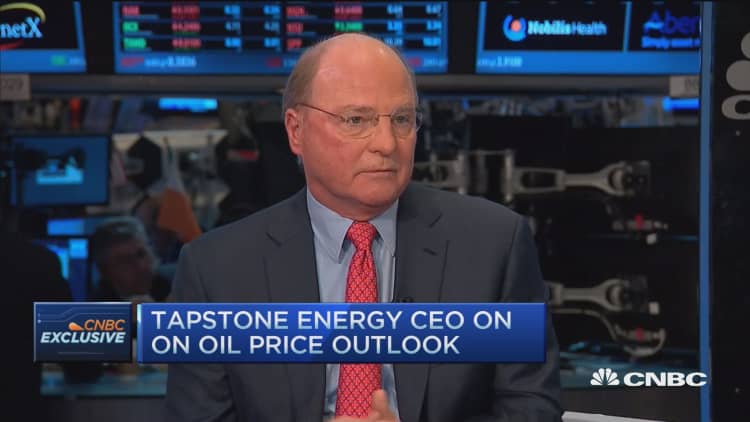
Just months after asking, "How low can it go?" oil analysts are raising price forecasts for 2017 and beyond. But they differ on how high it will go, and when.
Many firms see a gradual increase toward $80 a barrel in the coming years, but one believes the oil cycle will peak next year.
On Monday, Raymond James increased its already bullish forecast, calling for U.S. crude at $80 a barrel in 2017, up $5 from its previous forecast. Thereafter, it believes oil will fall to $75 in 2018 and $70 in 2019.
The firm made waves earlier this year when it said U.S. crude's West Texas Intermediate contract would be pushing $70 a barrel by December. Since then, oil prices have rebounded by 85 percent from a low of about $26 a barrel to nearly $50. They rose to just more than $51 earlier this month.
That gap in price forecasts is important. If an investor believes oil prices will peak next year, the case for buying into energy stocks becomes more urgent, since they typically correlate closely with crude futures.
So if Raymond James is right, investors on the sidelines would likely miss out on gains.
Raymond James cuts a lonely figure at $80 a barrel in 2017, though. Morgan Stanley recently increased its outlook to align with average futures market prices, putting 2017 oil at $51. It doesn't expect crude to hit $77 until 2019.
Piper Jaffray's Simmons & Co. International raised its forecast last week, but only to $60 in 2017 and $70 in 2018.
So what accounts for Raymond James' call? A combination of falling supply and more robust petroleum demand will converge with larger-than-expected reductions in global crude stockpiles, in its view. The firm cut its 2017 oil supply forecast by nearly 800,000 barrels per day, to about 96 million barrels.
To be sure, other analysts are reading some of the same tea leaves. As crude prices rise, many believe drillers will put that higher revenue toward repairing their balance sheets rather than plowing it into new production. Supply disruptions in Nigeria, Venezuela and Libya are widely expected to leave a mark, as well.
Overall, the firm's supply and demand forecasts are not very dissimilar from others' calls, though Raymond James does see higher demand growth this year than some peers do. But Raymond James analyst Pavel Molchanov cautioned against relying too heavily on supply and demand dynamics.
"There is no clear-cut, obvious linkage between what's happening to supply and demand and the price of oil. If there were, you wouldn't need analysts," he told CNBC.
"The reality is predicting oil prices is like predicting stock prices. It's more of an art than a science," Molchanov said.
Falling supply on three key fronts underpins the outlook. First, capital spending and drilling cutbacks in China and Colombia, disappointing deep-water results in Angola and poor offshore auctions in Mexico caused the firm to reduce its supply outlook by 400,000 barrels per day.
Last week, Wood MacKenzie reported investment spending by the global oil industry has fallen by $1 trillion since prices collapsed in 2014.

Second, those unplanned supply disruptions in Nigeria, Venezuela, Canada and Libya account for another 300,000 barrels of downward revisions.
Last, bottlenecks in the U.S. are seen as preventing American drillers from ramping up production even as prices rise. Those that aim to reverse massive layoffs may struggle to find workers as the United States approaches full employment, Raymond James warns.
Almost since the beginning of the downturn, energy industry recruiters warned that workers who left the oil patch may not return. Unable to staff up, drillers will face challenges in bringing on new supply.
"The reality is at $50 oil where we are today, global supply would barely stay flat, probably even continue to decline," Molchanov told CNBC's "Power Lunch" on Monday. "So we need $55, $60 to really stabilize production and then closer to $70 to actually begin to achieve meaningful supply growth."
Chesapeake Energy co-founder Tom Ward and Petrie Partners Chairman Tom Petrie recently told CNBC that prices need to top $70 a barrel before capital markets embrace the energy sector, allowing it to fund substantial, sustainable new production.
Given his $80 oil call, Molchanov said it's not time to be defensive. Rather than buy into dividend payers like Exxon Mobil, he is looking to names like Hess, Marathon Oil, Anadarko Petroleum, Newfield Exploration, Whiting Petroleum, and Continental Resources.
While Morgan Stanley and Piper Jaffray may not be as bullish on oil prices, they too are positive on exploration and production companies.


